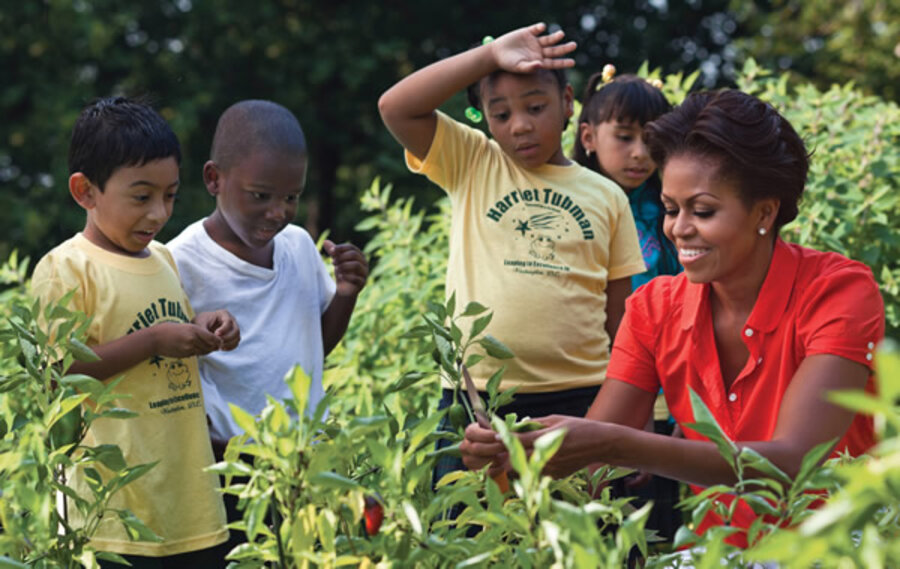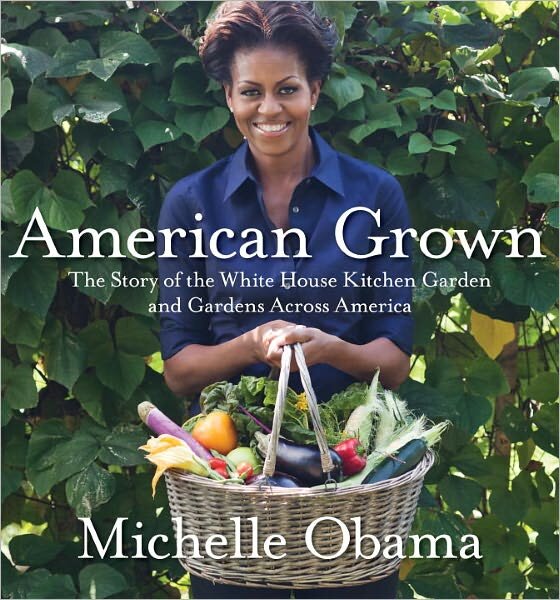American Grown by Michelle Obama
Loading...
Eleanor Roosevelt advocated for the poor. Jacqueline Kennedy ushered in culture. Nancy Reagan taught children to "Just Say No" to drugs. Laura Bush focused on early childhood development. While their presidential husbands fought wars, political battles, and tried to steady wavering economies, the first ladies of America have found their own outlets for leadership, often drawing national attention to domestic causes with the purpose of strengthening families and communities.
Michelle Obama has found her own noble cause right at the root level with a gardening and simple cookbook, American Grown. In her first book, she chronicles the transformation of the White House's South Lawn into a working kitchen garden. With the help of White House staff, the National Park Service, volunteers, and scores of local school children, she turns over what was once a stretch of grass into fertile soil for sprouts, beans, berries, lettuces, corn, squash, and a variety of herbs. There is even an active honey beehive nearby, strapped down to withstand the winds of the presidential helicopter, Marine One.
While a little patch of edible plants may not seem remarkable, "American Grown" serves as an off-shoot of Mrs. Obama's broader goal of teaching children the fun of healthy living. Her "Let's Move!" program has set the ambitious goal of solving childhood obesity within a generation. The statistics are sobering: Nearly 1 in 3 children in America are overweight or obese. In African-American and Hispanic communities the numbers are even higher, with nearly 40 percent of children overweight or obese. Normal activities that a lot of Americans grew up with – gym class and after-school sports programs – aren't always an option for school children today. The spread of convenience foods and sedentary video games has taken a toll on natural, youthful activity. “American Grown” strives to show that hard physical work + patience = pride of accomplishment and delicious, healthy meals.
The first lady's focus on the joys of discovering the better taste of locally grown food comes out of her own experience. Raised in the South Side of Chicago in a small apartment, she had little opportunity to learn about growing food during her childhood. "Vegetable gardening wasn't exactly a common pastime in the neighborhood where I grew up," writes Mrs. Obama.
As she began to raise her daughters, Malia and Sasha, their family pediatrician urged her to incorporate more vegetables and fruit into their meals. So Mrs. Obama made a radical change in what they ate and where they bought it. Heading to the farmer's market toting canvas bags to buy local fresh, produce opened a new world and planted the seed of creating a teaching moment for the nation’s youth well before her move into the White House.
“I first had the idea to plant a vegetable garden at the White House in my kitchen back in Chicago,” writes the first lady. “As the primary season, and then the general election season, wore on, I kept the idea of that garden in the back of my mind. Soon after my husband was elected, I began to think about how to make it a reality.”
And she didn't wait long to make it happen. In April 2009 Mrs. Obama broke ground with the help of 23 fifth-graders from Bancroft Elementary School in Washington, the National Park Service, and White House chefs. Not every thing went smoothly. The pumpkins didn't grow. Beautiful melons had no taste at all. The birds got all the blueberries. The president was leery about having a beehive installed near his basketball court.
But this is what makes "American Grown" a fun read. Mrs. Obama invites us to learn right alongside her as she and White House dog Bo wander the paths between raised beds. From her unique vantage point as a White House resident, she also sows in historical context. There is a Thomas Jefferson bed that grows heirloom peas descendent from those raised at the former president's Monticello residence. There are photos of the first White House kitchen garden – a modest Victory Garden – planted under the supervision of Eleanor Roosevelt. And there is the Children's Garden, created under Lady Bird Johnson, as a secluded place to play toward the lower part of the South Lawn. Just below that sits the new Kitchen Garden.
Involving children is at the heart of "American Grown" and it's a book that is engaging and simple enough to interest young readers.
Simple lessons are often the best as this elementary school student wrote in an essay about his day helping to plant the White House Kitchen Garden:
"One of the things that I want to say about being at the White House was how gentle the feeling was. It felt surprisingly 'natural,' to be there. It was all about nature, and what is natural," wrote David Martinez. "My teachers talk a lot about models for our assignments, and how we need to look at them and follow them when we do our own work. I think about the garden project as a model for being gentle: gentle with nature, gentle to your body, and gentle with each other."
In “American Grown,” the first lady visits community and school gardens all across the nation to encourage children to dig in the dirt. There are uncomplicated recipes pegged to each season’s bounty from White House chefs, and tips on everything from how to start your own garden to how to store fresh produce.
Mrs. Obama's timing is as impeccable as a well-timed spring planting – and not because we are at the brink of an all-out political battle for the presidential election. Her national spotlight raises up issues that a nation of foodies are already enamored with – we care about where our food comes from, who grew it, and what it tastes like. It's natural to have our leading family join us at the dinner table as Americans delight in a renaissance of real food.









